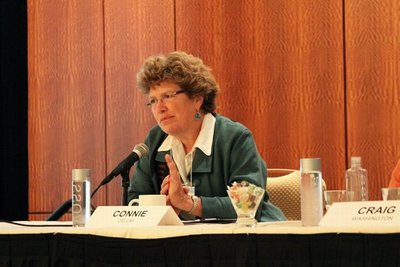November 19, 2009
Lessons learned from a major study on herpes and HIV: Our job is not done
In May, results of a major study measuring the impact of herpes suppression on HIV transmission were released. The Partners in Prevention study, conducted by the International Clinical Research Center, enrolling more than 3,400 HIV-discordant couples in seven African countries, was a huge undertaking. Had the results been positive, scientists would have gained a new strategy to reduce HIV transmission and dampen the spread of the pandemic.
Connie Celum, director of the International Clinical Research Center, offered insight into this trial in her talk Nov. 5, “HSV-2 (Herpes) and HIV: The Epidemiology, The Clinical Trials and the Lessons Learned” as part of the Center for AIDS Research Seminar series. The talk was recorded.
The study was based on 20 years of science showing a strong interaction between HSV-2, the virus most commonly associated with Genital Ulcerative Disease and HIV. Infection with HSV-2 is associated with a two-to-three-fold increase in the risk of acquiring HIV. Researchers hypothesized that HSV-2 suppression would reduce transmission of HIV but after six years dedicated to a Phase III, placebo-controlled, randomized clinical trial, researchers found that HSV-2 suppression does not reduce the acquisition or transmission of HIV.
“It shows that we need to keep working,” said Celum, lead researcher and UW professor in the Department of Global Health and Medicine. “Our job is not done.”
While Celum expressed disappointment with the results, she highlighted the importance of the scientific method and the necessity of clinical trials. Before the clinical trials, many assumed that HSV-2 suppression would work and many questioned the need to rigorously research this premise. She said that the study illustrated the importance of a well-done clinical trial and stressed the need for an HSV-2 vaccine.
The herpes virus affects one in five adults in the United States. The disease is treated with antivirals such as acyclovir, which was used in the study due to its low-cost and availability.
With the acyclovir treatment, shedding of the HSV-2 virus decreases and duration of genital ulcers shorten, which is why researchers suspected that it could also lead to decreased risk in HIV transmission and acquisition.
Still, the results showed that acyclovir did slow HIV progression by 17 percent to 19 percent and, since acyclovir is safe, it could be used as a potential mechanism for delaying the onset of AIDS. The role of acyclovir in HIV treatment will require more investigation.
Further, the study showed the dedication of the African participants who took two pills daily and came into the research clinics monthly for intensive counseling, treatment and research procedures.
Research in HIV-discordant couples is important since some studies suggest that stable, cohabiting couples who don’t know their HIV status comprise the largest proportion of new HIV infections in the generalized African HIV epidemic. New HIV prevention measures are needed for couples in sub-Saharan Africa.
Emily Lee is an undergraduate double majoring in Public Health and English.



